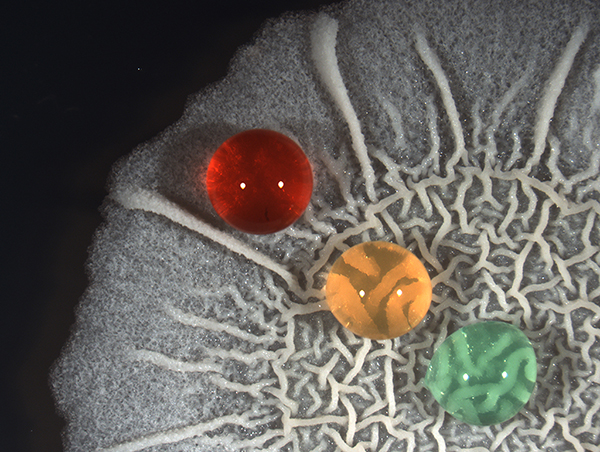Broadly speaking, I am interested in the complex, emergent collective dynamics of microbial populations across a range of spatial and temporal scales. My aim is to interpolate between the hierarchies of scales present in these phenomena and how they connect to one another-from gene expression to population-level spatial and temporal dynamics.
The basis of my research lies within the fact that natural bacterial habitats are often stressful, where local changes in temperature and nutrient availability, as well as competition with other microscopic organisms, influence how populations adapt to their surroundings and modify their survival strategies. Homogeneous environments such as culture flasks and agar plates are poor mimics. I utilize microfluidic and microfabrication technologies to engineer spatially structured environments with complex fitness landscapes to more closely simulate real-world bacterial habitats.
Microbial Collective Dynamics in Complex Topologies
 Click to enlarge
Click to enlarge
I spent the summer of 2016 in Bob Austin's lab at Princeton. With his group, we've been doing a range of experiments trying to better understand complex collective behaviours of E. coli in microfluidic/microfabricated habitats. We found that these microbes exhibit complex collective behaviours when faced with non-trivial problems to solve (e.g. a physical barrier). At an individual cell-level these 'problems' can not be surmounted, but as a collective they can. So far we have published some results on the observation that bacteria can defeat rectifying funnels by launching collective solitary waves against them (see paper below). I'm particularly interested in how these behaviours could play a role during infection or how it may impact the rates of anti-microbial resistance development. This work is still on going so I will talk much more about this as we near publishing some more results!
Selected publications
- Ryan J. Morris, Trung V. Phan, Matthew Black, Ke-Chih Lin, Yannis G. Kevrekidis, Julia A. Bos and Robert H. Austin
Bacterial population solitary waves can defeat rings of funnels
New J. Phys. (2017).
Bacterial Biofilms
 Click to enlarge
Click to enlarge
Biofilms are another form of complex collective behaviour exhibited by microbes. Biofilms are surface-associated, highly dense multi-cellular communities. These 'bacterial cities' are true communities in the sense that the residents are divided into metapopulations which have distinct roles such as promoting growth, conserving structural integrity and maintaining homeostasis. Moreover, these aggregate communities provide physical protection from invading predators and aid in decreasing the effectiveness of anti-microbial agents. To date, I have studied structural protein components of biofilms formed by the organism B. subtilis. These biofilms have the distinctive characteristic of being extremely hydrophobic. We have been uncovering the mechanisms by which a particular protein, BslA, confers this unusual property to the community. Much of this work has been with Prof. Cait MacPhee (Edinburgh) and in collaboration with Prof. Nicola Stanley-Wall's group at Dundee University. I'm particularlyl interested in employing microfluidic and microfabrication techniques to better understand the interplay between gene regulation/expression, cell-cell communication and how these processes impact larger scale biofilm structure.
Selected publications
- Sofia Arnaouteli, Ana Sofia Ferreira, Marieke Schor, Ryan J. Morris, Keith M. Bromley, Jeanyoung Jo, Krista L. Cortez, Tetyana Sukhodub, Alan R Prescott, Lars E.P. Dietrich, Cait E MacPhee, Nicola R Stanley-Wall
Bifunctionality of a biofilm matrix protein controlled by redox state
Submitted to PNAS (2017)
- Keith M Bromley, Ryan J Morris, Laura Hobley, Giovanni Brandani, Rachel MC Gillespie, Matthew McCluskey, Ulrich Zachariae, Davide Marenduzzo, Nicola R Stanley-Wall, Cait E MacPhee
Interfacial self-assembly of a bacterial hydrophobin
PNAS 112, 5419-5424 (2015). - Ryan J. Morris, Marieke Schor, Rachel M.C. Gillespie, Ana Sofia Ferreira, Keith M. Bromley, Lucia Baldauf, Sofia Arnaouteli, Tetyana Sukhodub, Adam Ostrowski, Laura Hobley, Chris Earl, Nicola R. Stanley-Wall, Cait E. MacPhee
Evolutionary variations in the biofilm-associated protein BslA from the genus Bacillus
Submitted to Scientific Reports (2016)
Protein Self-Assembly
 Click to enlarge
Click to enlarge
My PhD. was primarily focussed on building an understanding of the physical mechanisms which underlie the self-assembly of amyloid fibrils. Amyloid fibrils have garnered intense investigation primarily due to their implication in many human neurodegenerative diseases (e.g. Alzheimer's, Parkinson') but they have also increasingly attracted interest for their material properties. This work employs experiment, simulation, and theory to better understand the microscopic mechanisms which control both the rates of formation and the concomitant population of fibril species. I haven't been working much in this area as of late but still take an interest in the field.
Selected publications
- Kym Eden, Ryan Morris, Jay Gillam, Cait E MacPhee, Rosalind J Allen
Competition between primary nucleation and autocatalysis in amyloid fibril self-assembly
Biophys. J. 108, 632-643 (2015). - Juraj Szavits-Nossan, Kym Eden, Ryan J Morris, Cait E MacPhee, Martin R Evans, Rosalind J Allen
Inherent variability in the kinetics of autocatalytic protein self-assembly,
Phys. Rev. Lett. 113 , 098101 (2014) - Ryan J Morris, Kym Eden, Reuben Yarwood, Line Jourdain, Rosalind J Allen, Cait E MacPhee
Mechanistic and environmental control of the prevalence and lifetime of amyloid oligomers,
Nature Comm. 4 , 1891 (2013).